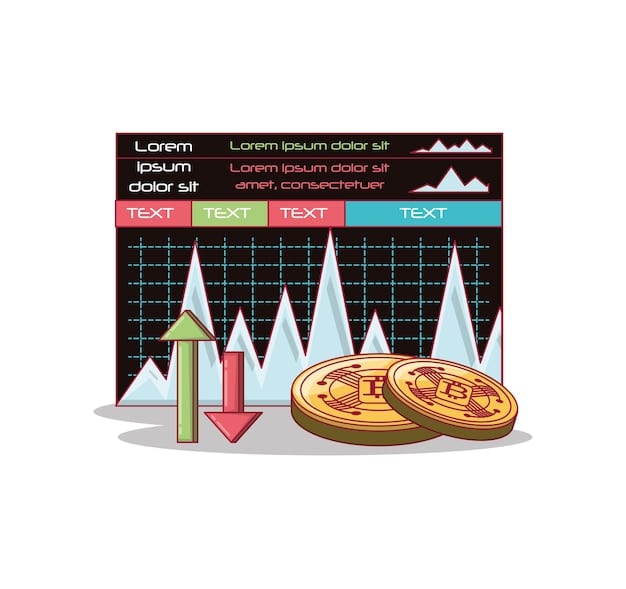Navigating Crypto Volatility: Risk Management in the US Market

Navigating crypto volatility in the US market requires a strategic approach incorporating diversification, risk assessment, and staying informed about market trends and regulatory changes to safeguard investments.
The cryptocurrency market is known for its wild price swings, presenting both opportunities and challenges for investors. Navigating crypto volatility: strategies for managing risk in the US market demands a proactive approach, combining knowledge, discipline, and the right tools to protect your investments.
Understanding Crypto Volatility in the US Market
Cryptocurrency volatility refers to the degree of price fluctuations experienced by digital assets over a specific period. Understanding its causes is crucial for developing effective risk management strategies.
In the US market, this volatility is influenced by factors ranging from regulatory news to technological advancements and shifts in investor sentiment.
Factors Influencing Crypto Volatility
Several factors contribute to the high volatility observed in the cryptocurrency market. These include:
- Market Sentiment: News, rumors, and social media trends can rapidly shift investor sentiment, leading to significant price changes.
- Regulatory Uncertainty: Regulatory developments in the US, such as potential taxation or restrictions, can trigger market volatility.
- Market Maturity: Compared to traditional financial markets, the crypto market is still relatively young and immature, leading to greater price swings.
These factors, combined with the 24/7 trading environment, create a unique landscape where prices can change dramatically in short periods.
Understanding these elements and their potential impact can significantly aid investors in mitigating risks associated with crypto investments.

Developing a Crypto Risk Management Strategy
A robust risk management strategy is essential for any cryptocurrency investor in the US market. This involves identifying your risk tolerance, setting clear investment goals, and implementing strategies to protect your capital.
Creating a good strategy helps minimize potential losses while maximizing the opportunity for gains.
Assessing Your Risk Tolerance
Before investing in cryptocurrencies, it’s crucial to assess your risk tolerance. This involves understanding how much potential loss you’re comfortable with.
- Define Your Investment Goals: Are you looking for short-term gains or long-term growth? Your goals will influence your risk tolerance.
- Evaluate Your Financial Situation: Consider your income, debts, and savings. Only invest what you can afford to lose.
- Understand Your Emotional Capacity: Can you handle the stress of seeing your investments fluctuate?
By honestly answering these questions, you can develop a risk profile that aligns with your financial and emotional capacity.
With a clear understanding of the risk and reward equation, one can start to invest more confidently.
Diversification: Spreading Your Crypto Investments
Diversification is a fundamental principle of risk management, particularly relevant in the volatile crypto market. By spreading your investments across multiple cryptocurrencies, you can reduce the impact of any single asset’s performance on your portfolio.
This approach can help reduce the risk of significant losses and enhance the potential for overall returns.
Benefits of Diversification
Diversifying your cryptocurrency portfolio offers several advantages:
- Reduces Specific Asset Risk: If one cryptocurrency performs poorly, the impact on your overall portfolio is minimized.
- Captures Broader Market Growth: By investing in multiple assets, you can benefit from the growth of different sectors within the crypto market.
- Potentially Increases Returns: A diversified portfolio can capture gains from various assets, potentially leading to higher overall returns.
Consider exploring different types of cryptocurrencies, such as large-cap coins (e.g., Bitcoin, Ethereum), smaller-cap altcoins, and stablecoins.
Diversification can shield the investor from the risks inherent in relying on one investment alone.
Using Stop-Loss Orders to Limit Losses
Stop-loss orders are an essential tool for managing risk in cryptocurrency trading. These orders automatically sell your crypto assets when they reach a specified price, limiting potential losses.
Implementing stop-loss orders can prevent emotional decision-making and protect your capital during sudden market downturns.
How Stop-Loss Orders Work
Understanding how to set and use stop-loss orders is vital for risk management:
- Setting the Stop Price: Choose a price level that is below your purchase price but still allows for normal market fluctuations.
- Types of Stop-Loss Orders: Consider using trailing stop-loss orders, which adjust automatically as the price of your asset increases.
- Placement Strategy: Avoid setting stop-loss orders too close to the current price, as this can lead to premature selling due to minor price dips.
Utilizing stop-loss orders can provide a disciplined approach to managing risk and protecting your investments from significant losses.
With the help of these orders, the investor can sleep at night.

Staying Informed and Adapting to Market Changes
The cryptocurrency market is constantly evolving; therefore, continuous learning and adaptation are crucial for successful risk management. Staying informed about market trends, regulatory changes, and technological advancements will enable you to make more informed investment decisions.
Constant study promotes the most current investing practices.
Sources of Information
To stay updated on the latest developments in the crypto market, consider the following resources:
- Reputable News Sources: Follow reliable financial news outlets that cover the cryptocurrency market.
- Industry Research Reports: Read research reports from reputable crypto analysis firms to gain insights into market trends.
- Community Forums: Participate in online forums and communities to exchange ideas and learn from other investors.
Staying informed and adapting your strategies as the market evolves will enhance your ability to navigate volatility and manage risk effectively.
By being vigilant and open to new information, you can be more resilient in this often volatile market.
Long-Term Investing vs. Short-Term Trading
Deciding between long-term investing and short-term trading requires a clear understanding of your investment goals and risk tolerance.
Each approach has its own set of advantages and disadvantages, particularly in the context of cryptocurrency volatility.
Key Differences
The choice between long-term investing and short-term trading can have significant implications for your risk management strategy:
- Time Horizon: Long-term investing involves holding assets for months or years, while short-term trading focuses on quick profits from short-term price fluctuations.
- Risk Exposure: Long-term investors are less concerned with daily price swings, while short-term traders must actively manage risk to avoid significant losses.
- Trading Frequency: Short-term traders make frequent trades, while long-term investors typically buy and hold.
Understand your personal investing preferences before jumping head first into the deep end of the investing pool.
Evaluate which method best fits your tolerance for change.
| Key Strategy | Brief Description |
|---|---|
| 🛡️ Diversification | Spread investments across multiple cryptocurrencies to reduce risk. |
| 🛑 Stop-Loss Orders | Automatically sell assets at a specified price to limit losses. |
| 📚 Stay Informed | Keep updated on market trends and regulatory changes. |
| 📏 Risk Assessment | Assess your risk tolerance and set clear investment goals. |
Frequently Asked Questions
▼
Crypto volatility refers to the degree and frequency of price changes in cryptocurrencies, often more extreme than traditional assets due to market immaturity and news sensitivity.
▼
Diversification spreads your investments across various cryptocurrencies, reducing the impact of any single asset performing poorly on your overall portfolio.
▼
Stop-loss orders automatically sell your crypto when it reaches a specified price, limiting potential losses during market downturns and preventing impulsive decisions.
▼
The crypto market is rapidly evolving, so staying informed about new trends, technologies, and regulatory changes helps improve decision-making and manage risks effectively.
▼
The choice depends on your risk tolerance and goals. Long-term is less risky but slower, while short-term offers quicker gains with much higher risk from volatility.
Conclusion
Navigating crypto volatility: strategies for managing risk in the US market requires a multifaceted approach. By understanding volatility, diversifying investments, using tools like stop-loss orders, staying informed, and aligning your strategies with your risk tolerance, you can navigate the crypto market with greater confidence and protect your investments.





